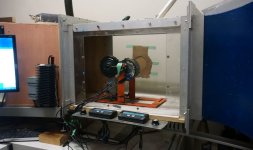I've been noticing a lot of people complaining about all kinds of mid-drives where they have to keep the rpm's up in a low gear or there either will be inadequate power or the motor/controller will start to overheat. So they have to put it in such a low gear that the optimal cadence for pedaling is over 100, and they have to ghost pedal to get the desired amount of power from a low gear.
I've been running a lot of simulations on the Grin webpage...it really looks like the limiting factor (besides the motor itself overheating) is the max amps of the controller. A controller that has more max A rating is going to handle the increased current better --- so why don't the manufacturers simply provide a stock controller that can handle more amps coming through? Are they afraid the motor will burn out so they put on a mediocre controller so that dies first?
Example: let's say you have a 500W mid-drive with 100 Nm torque; in order to get the correct torque you have to run the cassette cog as 1:1 with the chainring, so let's say 42T chainring and 42T in this case lowest cog. And let's say 500W motor power, 40 volts going through, 12.5 amps at 400 rpm. But you may only be going 3-4 mph up a 10% grade and a non-ebike can do almost that mph without any electric power! So it becomes ridiculous. You want to go faster. You have the power, you just don't have the right controller to handle the gearing. 22A max controller.
So you upshift into 21T. Now the torque may fall to 50 nm but the speed will increase. To get the same 500W with only this time around 200 rpm motor speed, the lower rpm limits the volts going to the motor to 20. That means you need 25 amps and the controller will only allow 22A. So it either kicks down to a lower power (which means your climb either gets much harder or is over), it shuts off, or it overheats and may get damaged. But what if you had 30+A controller on there. Then the 25A would not be so bad. The question then becomes: if a mid-drive motor is rated 500W, 48V (and therefore nominal 10.4A), how many more amps can it realistically take on a climb if the controller can handle 30+ amps? Can it take 20 continuous amps for 10 minutes or more? 25A? 30A? The larger controller can take it, but can the motor. If yes, then just get a more heavy-duty controller and stop ghost pedaling.
I've been running a lot of simulations on the Grin webpage...it really looks like the limiting factor (besides the motor itself overheating) is the max amps of the controller. A controller that has more max A rating is going to handle the increased current better --- so why don't the manufacturers simply provide a stock controller that can handle more amps coming through? Are they afraid the motor will burn out so they put on a mediocre controller so that dies first?
Example: let's say you have a 500W mid-drive with 100 Nm torque; in order to get the correct torque you have to run the cassette cog as 1:1 with the chainring, so let's say 42T chainring and 42T in this case lowest cog. And let's say 500W motor power, 40 volts going through, 12.5 amps at 400 rpm. But you may only be going 3-4 mph up a 10% grade and a non-ebike can do almost that mph without any electric power! So it becomes ridiculous. You want to go faster. You have the power, you just don't have the right controller to handle the gearing. 22A max controller.
So you upshift into 21T. Now the torque may fall to 50 nm but the speed will increase. To get the same 500W with only this time around 200 rpm motor speed, the lower rpm limits the volts going to the motor to 20. That means you need 25 amps and the controller will only allow 22A. So it either kicks down to a lower power (which means your climb either gets much harder or is over), it shuts off, or it overheats and may get damaged. But what if you had 30+A controller on there. Then the 25A would not be so bad. The question then becomes: if a mid-drive motor is rated 500W, 48V (and therefore nominal 10.4A), how many more amps can it realistically take on a climb if the controller can handle 30+ amps? Can it take 20 continuous amps for 10 minutes or more? 25A? 30A? The larger controller can take it, but can the motor. If yes, then just get a more heavy-duty controller and stop ghost pedaling.




